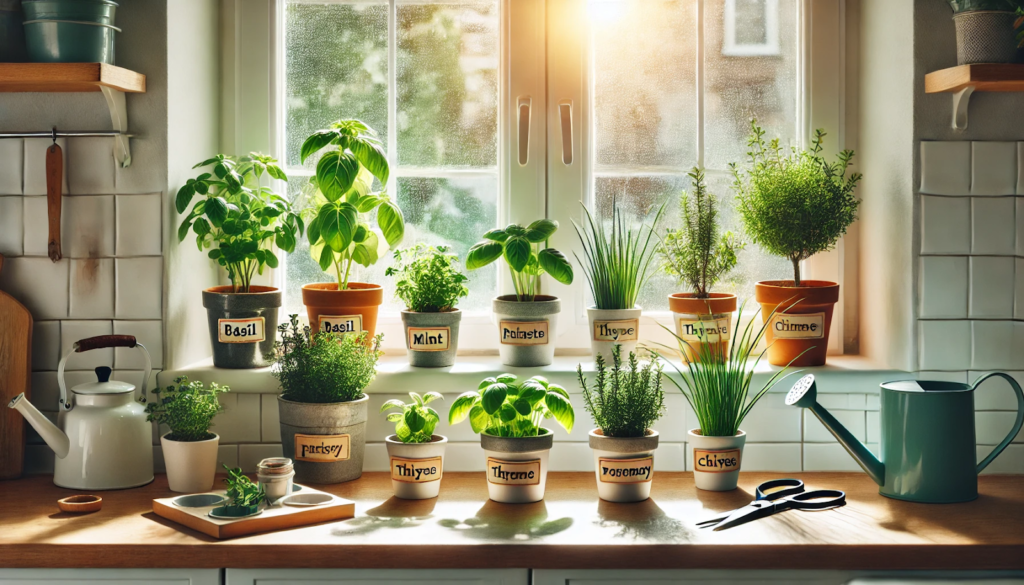Growing herbs in your kitchen is a simple and rewarding way to bring fresh flavor, fragrance, and greenery into your home. Whether you’re an avid home cook or just want to add life to your windowsill, kitchen herbs are easy to grow, require minimal space, and provide continuous harvests throughout the year.
This guide covers the best herbs to grow indoors, how to care for them, and practical tips for creating your own kitchen herb garden.
Why Grow Herbs in the Kitchen?
- Fresh flavor on demand — snip just what you need.
- Cost-effective — no need to buy plastic-wrapped herbs.
- Space-saving — grows well in small containers or on a windowsill.
- Easy access — harvest while cooking without stepping outside.
- Aromatic and decorative — adds life and scent to your cooking space.
Best Herbs to Grow Indoors
Here are the top kitchen-friendly herbs that thrive indoors:
1. Basil
Basil is a warm-weather herb that’s perfect for windowsills with good sunlight.
- Light: 6 hours of direct sunlight or use grow lights.
- Water: Keep soil consistently moist but not soggy.
- Use: Pesto, salads, pasta, and pizza.
Tip: Pinch off flowers to encourage leafy growth.
2. Parsley
Parsley grows well indoors and provides vitamins and a fresh, clean flavor.
- Light: Bright, indirect light; tolerates partial shade.
- Water: Allow soil to dry slightly between watering.
- Use: Garnishes, soups, sauces, and salads.
Tip: Harvest outer stems first to promote bushiness.
3. Mint
Mint is incredibly hardy and spreads easily—perfect for container growing.
- Light: Bright, indirect light.
- Water: Keep soil moist; don’t let it dry out.
- Use: Teas, desserts, cocktails, and savory dishes.
Tip: Grow in a separate pot to prevent it from invading other herbs.
4. Chives
Chives are low-maintenance and grow quickly. Their onion-like flavor enhances many dishes.
- Light: Full sun to partial shade.
- Water: Water when the topsoil is dry to the touch.
- Use: Eggs, soups, dips, and potatoes.
Tip: Snip leaves regularly to encourage new growth.
5. Thyme
Thyme is a slow-growing herb with a strong, savory flavor. It’s drought-tolerant and ideal for windowsill gardening.
- Light: Full sun; needs at least 6 hours of light.
- Water: Let the soil dry out between waterings.
- Use: Roasted vegetables, meats, and marinades.
Tip: Trim woody stems to keep the plant compact.
6. Rosemary
This pine-scented herb thrives with proper sunlight and care.
- Light: Needs strong light—south-facing window or grow light.
- Water: Water when top inch of soil is dry.
- Use: Breads, poultry, potatoes, and stews.
Tip: Avoid overwatering; rosemary doesn’t like soggy roots.
7. Oregano
Oregano is a Mediterranean herb that grows well in warm, dry conditions.
- Light: 6+ hours of bright light.
- Water: Water when the soil is dry to the touch.
- Use: Pizza, sauces, meat dishes, and soups.
Tip: Use fresh or dry the leaves for long-term storage.
Ideal Growing Conditions for Kitchen Herbs
- Containers: Use small pots (4–6 inches) with drainage holes.
- Soil: Well-draining potting mix with organic compost.
- Watering: Avoid overwatering—check soil moisture regularly.
- Fertilizer: Use diluted organic liquid fertilizer once a month.
- Airflow: Keep herbs near an open window or fan to reduce mold risk.
Light Requirements
Light is critical for healthy herb growth. If your kitchen doesn’t get much natural light:
- Use LED grow lights for 12–14 hours per day.
- Place herbs as close to the window as possible.
- Rotate plants weekly for even growth.
Harvesting Your Herbs
Proper harvesting encourages more growth and fuller plants.
How to Harvest:
- Use sharp scissors or herb snips.
- Cut above a leaf node (where two leaves grow).
- Never take more than 1/3 of the plant at once.
Drying & Storing:
- Air-dry herbs upside down in a dry, ventilated area.
- Store dried herbs in airtight containers for later use.
Common Problems & Solutions
| Issue | Cause | Solution |
| Yellow leaves | Overwatering | Let soil dry before next watering |
| Leggy growth | Lack of light | Move closer to window or use grow light |
| Drooping | Underwatering or root-bound | Water or repot plant |
| Pests (aphids, gnats) | Overwatering or poor airflow | Use neem oil or insecticidal soap |
Creative Kitchen Herb Garden Ideas
- Windowsill planters — line up matching pots for a uniform look.
- Hanging planters — great for mint and trailing herbs.
- Mason jar gardens — decorative and compact.
- Wall-mounted herb shelves — save counter space.
- Magnetic pots on fridge — fun and functional.
Fresh Flavor, Anytime
A kitchen herb garden transforms your cooking routine and brings a bit of nature indoors. With minimal effort and a few basic tools, you can enjoy fresh, aromatic herbs at your fingertips every day. Start with your favorites and grow from there—you’ll wonder how you ever cooked without them.






